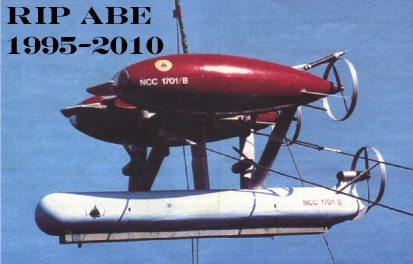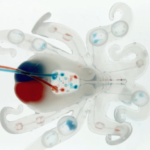
It is with great sadness and a heavy we report on the loss of the Autonomous Benthic Explorer (affectionately known as ABE). It was lost at sea last week during a research expedition to the Chilean Subduction Zone as part of the INSPIRE expedition (INternational Southeast Pacific Investigation of Reducing Environments). I’ve known about since the beginning, but writing about the loss of valuable and important deep-sea research equipment is always very difficult to come to terms with, only superceded by the loss of ships and human life. The Maritime Professional reports the details:
“ABE was brought out of retirement to be used during the mission to explore the Chile Triple Junction, because its replacement vehicle, Sentry had already been committed to another research expedition. The expedition to the Chile Triple Junction, the only place on Earth where a mid-ocean ridge is being subducted (or pushed beneath) a continent (South America) in a deep ocean trench, began February 24 and is scheduled to run through March 17.
On ABE’s first dive on the research cruise, it had detected evidence of hydrothermal vents. At the time of its loss, ABE had just begun a second dive to home into a vent site and photograph it. ABE was launched from the Melville about midnight local time for its descent to the seafloor.
“After a smooth launch, the dive began normally,” scientists and engineers on the ABE team reported. “ABE actively homed to its assigned position, reached the seafloor, released its descent weights, then leveled off to check its ballast. After this point, we received no more acoustic returns from the vehicle on either of its two transponders”—undersea acoustic devices that transmit and receive sound signals between vehicle and ship. The loss had nothing to do with earthquake activity off Chile, the scientists said.
ABE was equipped with several independent systems to bring it back to the surface at the end of a dive or should a fault occur. The Melville remained in the vicinity to see if ABE had resurfaced, at first searching for ABE’s strobe lights in the darkness. Researchers tried to establish radio contact with ABE in the event it had surfaced, but attempts turned up nothing.”
It is put most nicely by Chris German, WHOI’s National Deep-Submergence Facility chief scientist and a co-chief scientist for the Chile Triple Junction expedition:
“ABE was a vehicle that we’ll always have fond memories of— it was a world-beater in its day. In a way, it’s fitting that its demise comes on the job, and that it has gone to be recycled through the Chile subduction zone.”






I’m amazed at some of the discoveries that have been made on the bottom of the ocean. What a shame to see such a great piece of technology lost. I can only imagine what insights this machine bought to humankind. One of the great mysteries of the world, the bottom of the sea is able to be understood a lot more by us because of great human inventions such as ABE.
Has technology changed much for these type of machines over the last 15 years?
May she rest in peace. Until the day she gets rediscovered by chance? Stranger things have happened.
Like the camera
footage of the recently discovered Air France Airbus wreckage in the Atlantic.
Poor ABE, he will be missed. It is amazing that we have such technology that allows us to make advancements in deep sea studies. How much would a unit like this cost or be worth?
Anthony Parker
Aurora, CO
My Blog: cherokee scrubs
I’ve always disagreed with those who say you can’t form an attachment to a piece of inanimate machinery (like a car). Clearly the Deep-Sea News personnel see things like I do.
I can only imagine the loss they feel.
I agree Dave. After spending an extensive amount of time working on or with a piece of equipment you definately start to develop a bond.